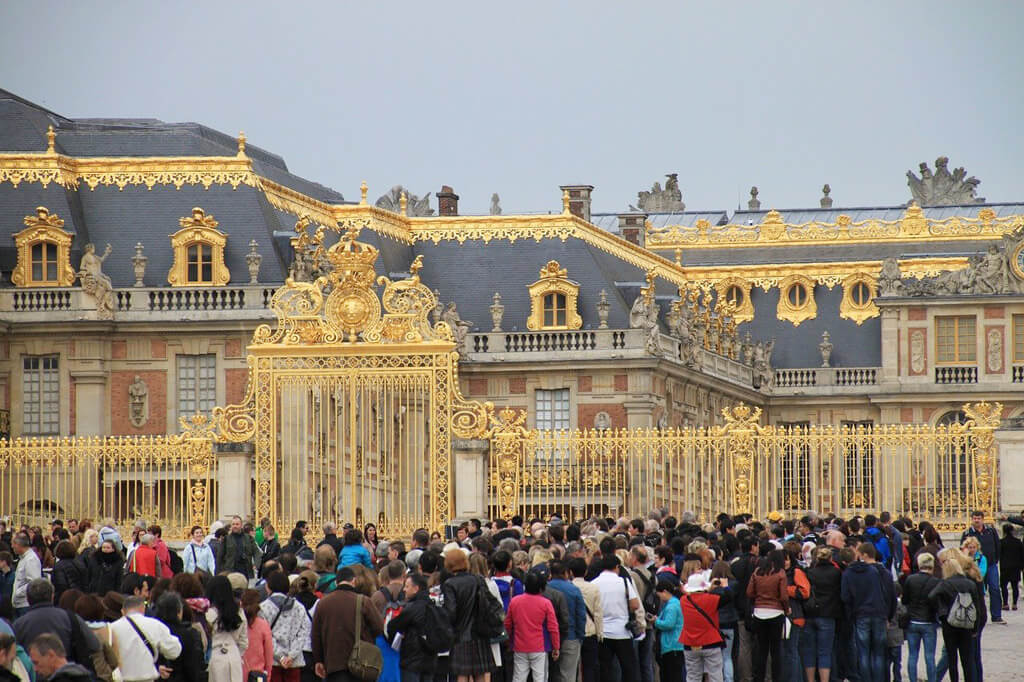Visit the Palace of Versailles Inside
Can you go inside the Palace of Versailles? YES, it is possible to visit Versailles inside. Actually, in our opinion, no visit to Paris would be complete without seeing the Palace of Versailles with your own eyes!
Château de Versailles is one of the most beautiful castles in France and a jewel of French Baroque architecture. The Palace of Versailles’ interior is a feast for the eyes, plus some of the most important moments in French history happened in this Palace, a fascinating history that you can learn by visiting its different rooms and halls.
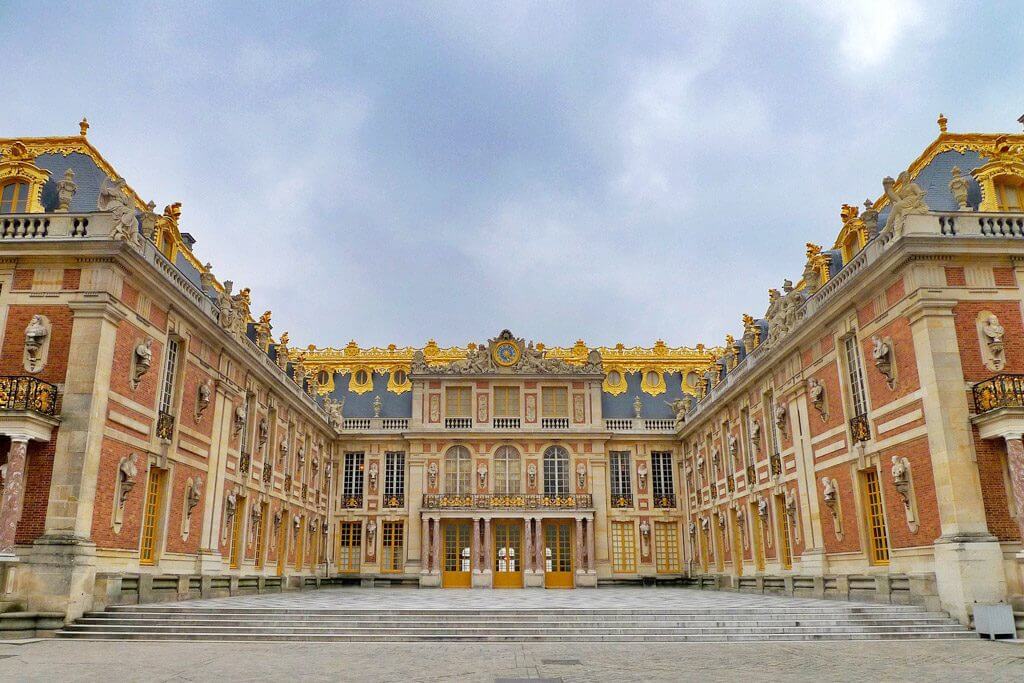
If this is your first time in Versailles, visit the Palace of Versailles inside. You will have to book a specific date and time slot for your visit to Château de Versailles. Try to book your Versailles tickets online as soon as you can, as the best time slots tend to sell out very fast!
Château de Versailles is one of the must-see castles near Paris, located only 21 km from the French capital. We recommend visiting the Versailles Palace in the following Paris itineraries:
This article is about the Palace of Versailles inside. It offers a peek inside the Palace of Versailles – things to know, how to visit Versailles, the musts – and our best tips.
If you are looking for information on how to visit Versailles from Paris, the articles below are in-depth guides to planning your Versailles trip.
Château de Versailles in a Nutshell
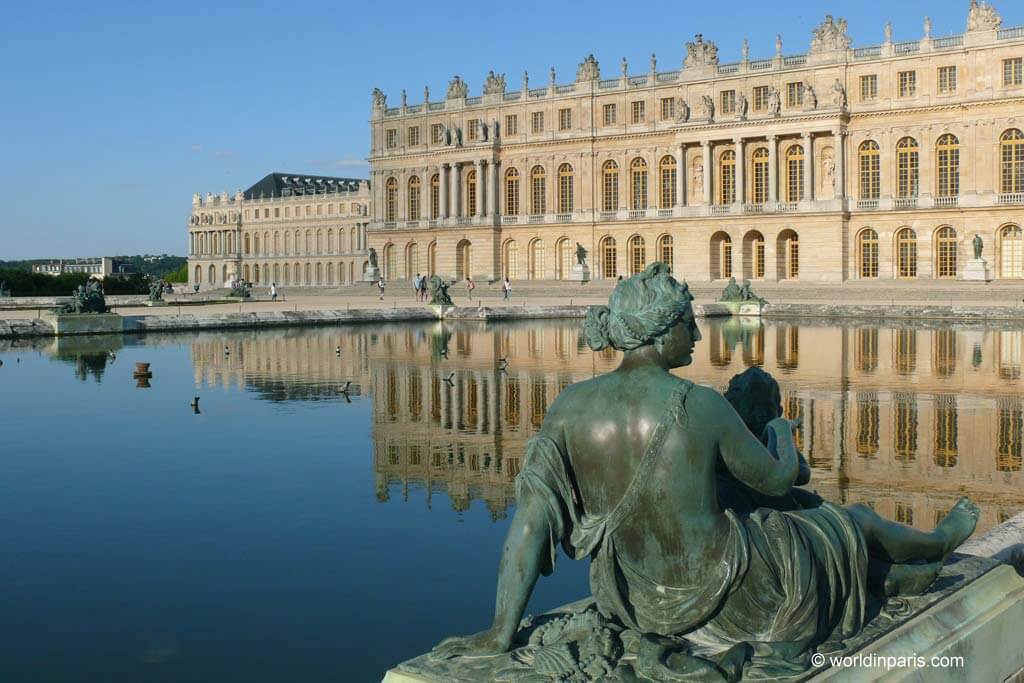
Versailles is one of the most popular day trips from Paris. Check out the list of best day trips from Paris.
Château de Versailles, or Palace of Versailles, was home to three French Kings and their courts.
- King Louis XIV and his wife Queen Maria Theresa of Spain
- King Louis XV (great-grandson of King Louis XIV) and his wife Queen Marie Leszczyńska
- King Louis XVI (grandson of King Louis XV) and his wife Queen Marie-Antoinette
The Château de Versailles was built in 1623 as a hunting lodge for King Louis XIII and became a popular spot for royalty to go hunting.
King Louis XIV moved to Versailles in 1682. The young King was wary of Paris, a city that he saw revolt in 1648. The city was seen as a dangerous concentration of epidemics, fires, floods, congestion, and disorders of all kinds.
The Sun King and his successors turned Louis XIII’s old hunting lodge in Versailles into a seat of power. With the Gardens and the Palaces of Trianon, the Versailles Estate spreads over 800 hectares!
The Palace of Versailles is surrounded on three sides by formal gardens (known as Petit Parc). The Versailles Gardens are beautifully decorated with fountains and sculptures. The Fountains of Versailles are the gardens’ main highlight.
Beyond the formal gardens, there’s a beautiful forest (known as Grand Parc) and the Grand Canal. This area is best explored by bike.
Versailles’ heydays ended abruptly when the Royal Family was forced to leave the Palace in 1789 (see our article about the French Revolution in Paris).
GOOD TO KNOW: Château of Versailles or Palace of Versailles? The official name in France is Château de Versailles, but abroad, it is mostly known as the Palace of Versailles, especially amongst the Anglo-Saxon people. Versailles’ official site uses Château de Versailles for its site domain and French version but switches to “Palace of Versailles” or “Palacio de Versalles” for the English and Spanish versions. Because our readers are mostly from the US, we decided to use Palace of Versailles for this article, but we are French, so we can’t help writing Château de Versailles from time to time as a reminder 😉
How to Visit the Palace of Versailles
It is possible to visit inside Palace of Versailles with or without a guided tour.
If you prefer a self-guided tour, you have different ticket options:
>> Versailles Palace skip-the-line ticket. When booking this ticket, you will have to choose a specific date and time slot. This is a personal ticket that must be used at the chosen time slot (or the following half-hour). With this ticket, you can also visit the French Gardens for free from 1 November to 31 March. From 1 April to 31 October, the Gardens host different shows, and there’s an entrance ticket to access the Gardens.
If you visit the Palace of Versailles with children or other people eligible for free admission, you need to book tickets also for them. This is to limit the number of visitors inside Versailles. When you pay, you will see that the price for them is still 0 €.
>> Versailles Passport ticket. This passport gives full access to the Palace of Versailles, its Gardens, and the Estate. The Estate includes the Grand Trianon, the Petit Trianon, and the Queen’s Hamlet. This Versailles Passport is much more convenient than buying different tickets separately.
>> Versailles Passport ticket 2 days (same link as the Versailles Passport ticket, then choose the Passport 2 days). Versailles Estate is so big that you may want to spend one night on-site to visit everything at your own pace and enjoy the different Garden Shows. Book a hotel near the Palace of Versailles and get the most out of Versailles Estate and the city in two full days.
>> Paris Museum Pass 2, 4, or 6 days. A visit to the Palace of Versailles, the Trianons, and Marie-Antoinette’s Domain is included in this pass. The pass, however, does not include access to the Gardens during the Garden Shows and Fountain Shows. You can read our Paris Museum Pass review here.
If you don’t plan to book a guided tour of Château de Versailles, remember to pick up the free audio guide at the entrance. It explains each of the rooms in great detail. Most of the visitors spend 2 to 3 hours inside Palace of Versailles.
There’s a variety of guided tours, and they come with or without a visit to the grounds.
>> A Versailles Palace skip-the-line guided tour usually takes 1.5 hours. Step inside Versailles Palace via a priority entrance (not the normal entrance) and follow an expert guide through the lavish halls of this iconic French architectural masterpiece.
>> With a Versailles short tour, visit the Palace of Versailles with a guide, take a stroll around the gardens, and get back to Paris.
>> Visitors on a day-long visit to Versailles have time to explore the Versailles Estate as well and get more time to visit the grounds.
A Peek Inside Palace of Versailles
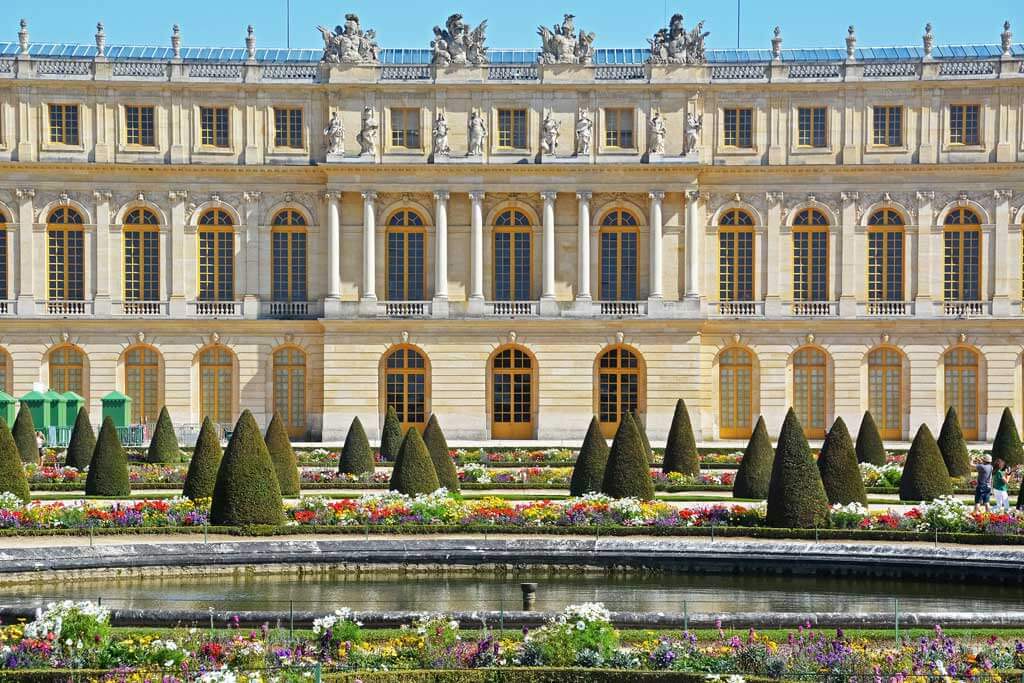
Explore the world within the walls of the magnificent Château de Versailles! What’s inside the Palace of Versailles? The visit consists of a one-way itinerary that goes through the following areas:
- Marble Court
- The King’s State Apartments
- Hall of Mirrors
- The Queen State Apartments
- The Gallery of Battles
Before visiting the Versailles Palace inside, there are a few things good to know:
>> The Palace of Versailles, as we can see it today, was mainly constructed in the 17th century with some additions by King Louis XIV’s successors in the 18th century.
>> Its architectural style is French Baroque. Baroque architecture is a highly decorative and theatrical style that appeared in Italy in the early 17th century and gradually spread across Europe.
>> Three names to remember related to the construction of Château de Versailles are Jules Hardouin-Mansart (the main architect of Versailles), Charles Le Brun (interior designer), and André Le Notre (landscape designer).
During the summer months, the Palace of Versailles gets exceptionally crowded, so being aware of what rooms to see and what to miss helps. Here is a list of what to expect inside Versailles Palace – the musts at Versailles Palace.
1. The Royal Gate
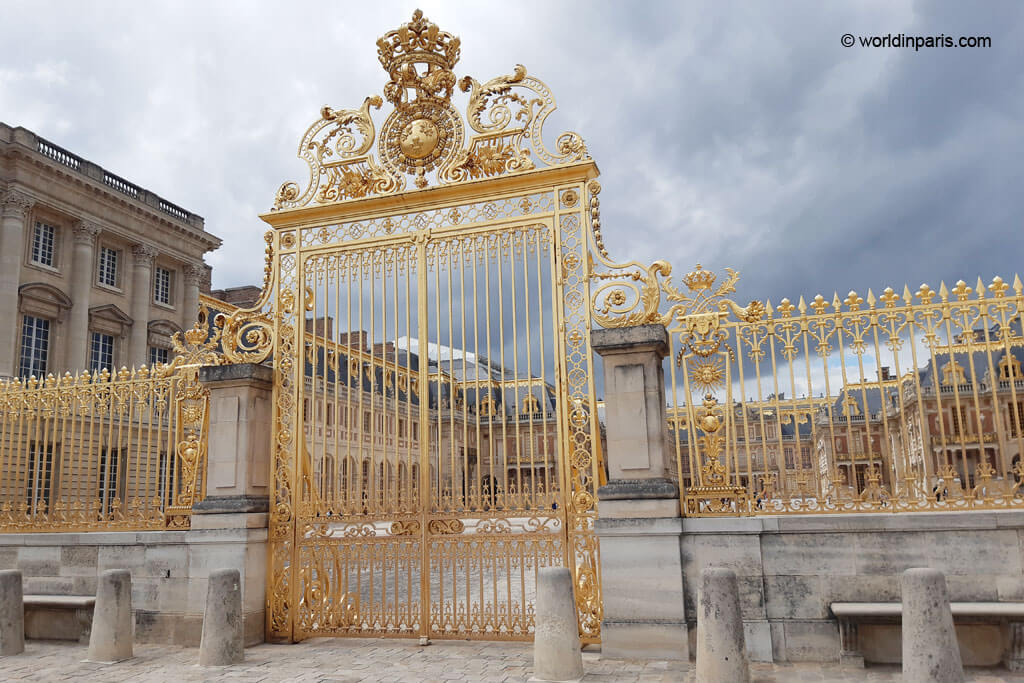
The Royal Gate is the main entrance to the Palace of Versailles and separates the Cour d’Honneur from the Cour d’Armes. This 80-meter gate, designed in Baroque style by Jules-Hardouin Mansart (the architect of the Palace), is made of gilded rough iron, and it is decorated with 100,000 gold leaves.
The current gate is a reconstitution of the original one, which was torn down during the French Revolution. Historians are not very happy with this work because it is a modern invention that would vaguely correspond to what the grid might have been at the time of King Louis XIV. However, you can’t deny that it looks very beautiful.
This reconstruction (2008) cost eight million US dollars, funded by private donors. While you are waiting to access the Palace, don’t miss its beautiful details, such as the royal crown, the sun, and the fleur de lis, all symbols of King Louis XIV.
TIP: The only original royal gate in Versailles can be found at Le Potager du Roi (King’s Kitchen Garden), and it separates the Royal Kitchen Garden from the Royal Gardens. The Potager du Roi is not part of the current Versailles Estate (not included in the Versailles Passport ticket), but it is well worth the visit.
2. Cour de Marbre – Marble Court
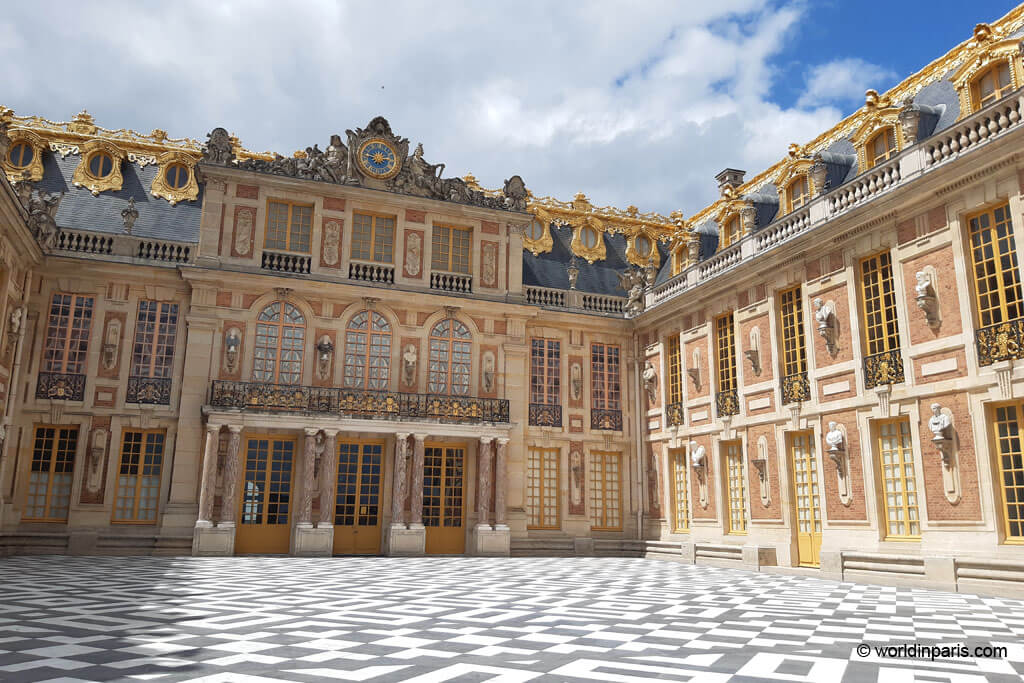
After validating the ticket and the security check, visitors usually head straight to the King’s State Apartments. Before, please-please take the time to admire the Marble Court.
The marble courtyard is the courtyard of the primitive Château occupied by King Louis XIII. It is paved with white and black marble tiles from the castle of Vaux-Le-Vicomte, according to the wishes of his successor King Louis XIV.
At this place, we are thus in the heart of Versailles. The U-shaped building that surrounds this courtyard has retained the style of the old hunting lodge of the times of King Louis XIII. King Louis XIV’s architects later embellished this facade, adorned with sculpted bas-reliefs and statues representing Roman emperors in particular. The slate roof with broken attics “à la Mansart” is adorned with gilding.
The marble court is separated from the royal court by five steps, which makes this court a more intimate space. If you look up, you will see the windows of the King’s bedroom (on the first floor at the level of the balcony and the semicircular windows).
3. Apollo Salon
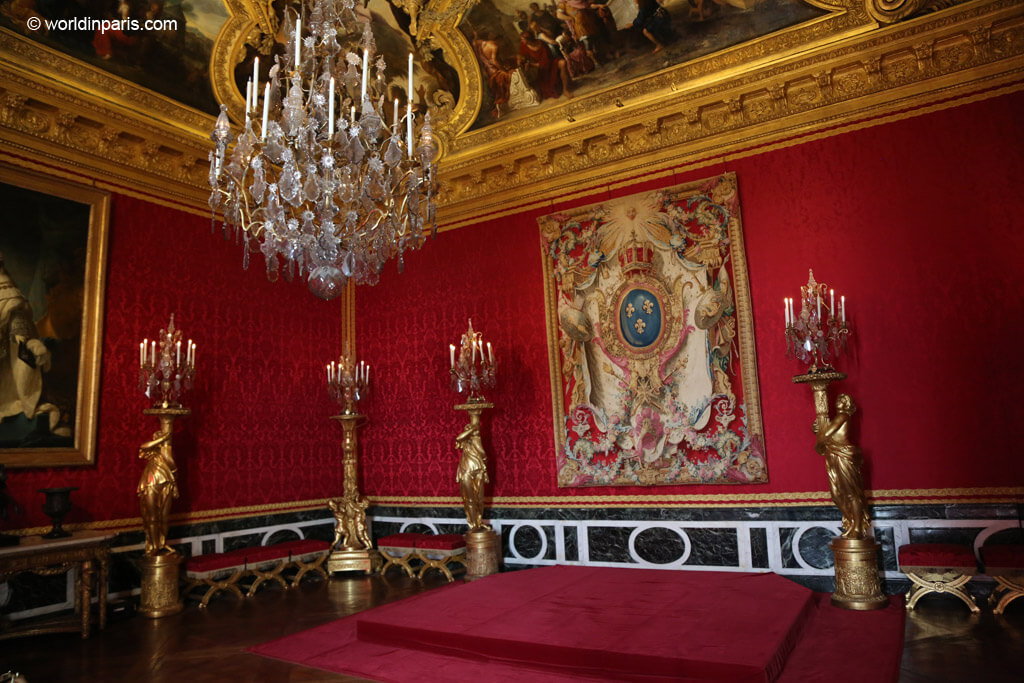
The King’s State Apartments include the King’s private, business, and reception rooms. These are some of the most famous rooms inside Palace of Versailles.
When you visit Versailles Palace inside, concentrate all your energy on this part of the Palace for a lighter visit to the other rooms.
Most salons are dedicated to a Greek God or Goddess, who usually appears in the rooms’ decoration under different forms.
Among these salons, the Apollo Salon is the most important. King Louis XIV identified himself with Apollo, the Sun God, and it is here where we find the throne room. The silver furniture and the 2.6-high throne have disappeared, but the decoration gives us an idea of how impressive this Salon was!
4. Royal Chapel
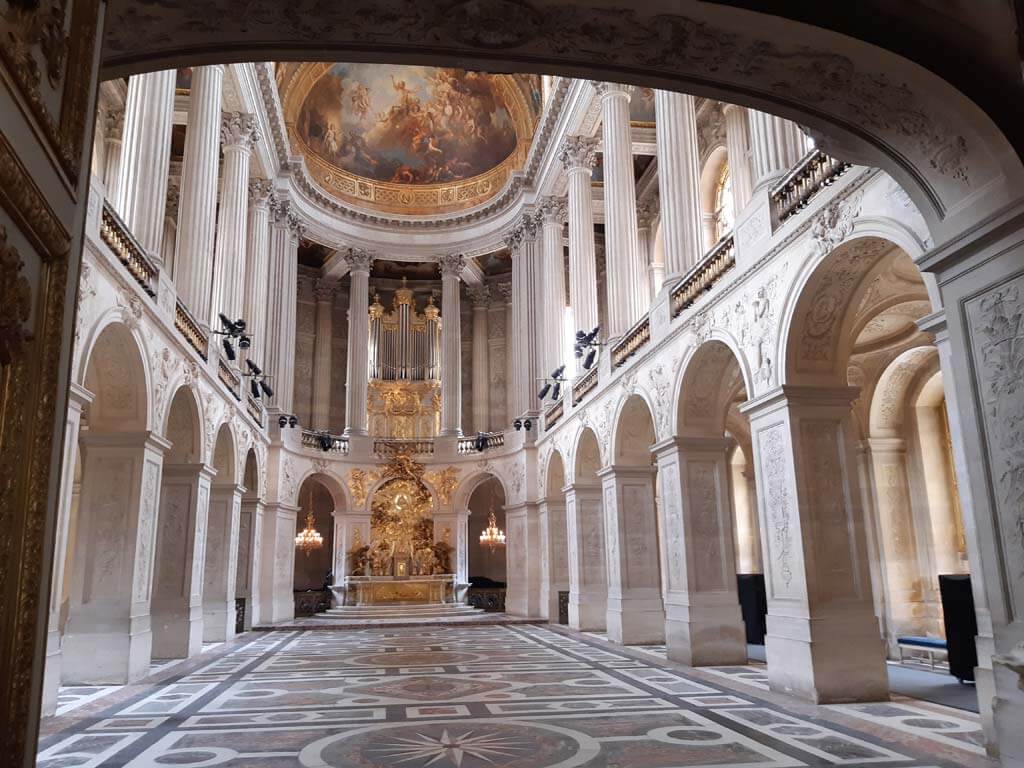
The Royal Chapel inside the Palace of Versailles is the fifth one to be built within the premises. It was recently restored and looks amazing. The Royal Chapel is inspired by Gothic architecture and is dedicated to Saint Louis, the King’s patron saint.
The work was entrusted to the architect Jules Hardouin-Mansart. The construction started in 1687 and lasted 23 years. Unfortunately, Mansart died in 1708, and the work was completed by Robert Cotte.
The fruit of much reflection by the King’s artists, and the King himself, the Royal Chapel can be considered the pinnacle of what King Louis XIV achieved at Versailles. King Louis XIV followed all the stages of the work. He had the plans revised, was attentive to the realization of the sets of sculptures and paintings, and even invited his musicians to test the acoustics!
The Royal Chapel was the setting for the sumptuous religious ceremonies of Court life, from the King’s daily mass to the magnificent meetings of the Order of the Holy Spirit and the baptisms and marriages of the Children of France, which were celebrated there from 1710 to 1789.
Every day at 10 am., the Court attended the King’s mass. The King stood in the royal gallery upstairs, surrounded by his family. The ladies of the Court occupied the side stands. In the nave were the “officers” and the public.
The King only went down there for the great religious holidays where he took communion, for the ceremonies of the Order of the Holy Spirit, and for the family celebrations such as baptisms and marriages. Future King Louis XVI and Marie-Antoinette got married in the Royal Chapel.
Unfortunately, the chapel is no longer open to visitors. It remains visible from the outside of the doors on the two floors.
5. Hall of Mirrors
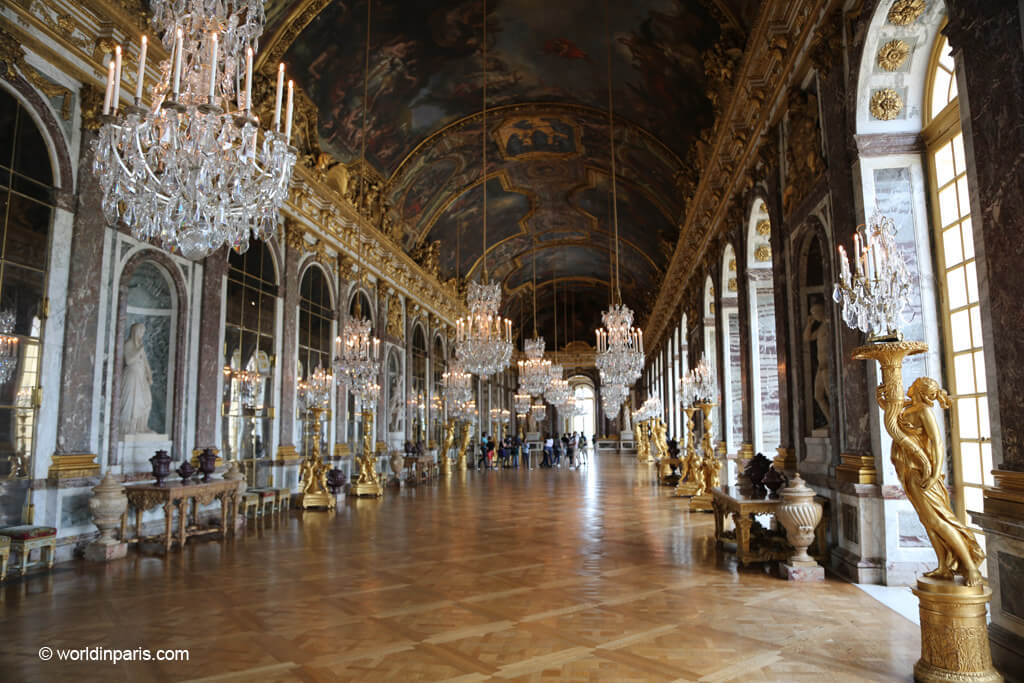
This is the most magnificent room inside Palace of Versailles, a 73-meter gallery with a beautiful vaulted ceiling and impressive chandeliers. The King used this gallery to go to the Royal Chapel and the Queen’s apartments every day.
This gallery was also used for elegant balls and important audiences, with the room originally being lit by as many as 20,000 candles to transform it into a “corridor of light” during special occasions.
The Hall of Mirrors has also been a witness to some of the most important moments in history, the most significant being the signing of the Treaty of Versailles. The Treaty of Versailles (28 June 1919) brought World War I to a close, ending the state of war between Germany and the Allied Powers.
The design of the Hall of Mirrors was inspired by the Apollo Saloon in the Louvre Palace. Construction began in 1678 under the architect Jules Hardouin Mansart. There are 357 mirrors in the hall, which at the time were among the most expensive items to possess. Venice had the monopoly on making mirrors, but King Louis XIV managed to entice (read steal) Venetian mirror makers to come over to create some, especially for the palace.
Later, the Hall of Mirrors was a source of inspiration for the Grand Foyer at the Opéra Garnier. The Opéra Garnier was designed by Charles Garnier in the 19th century.
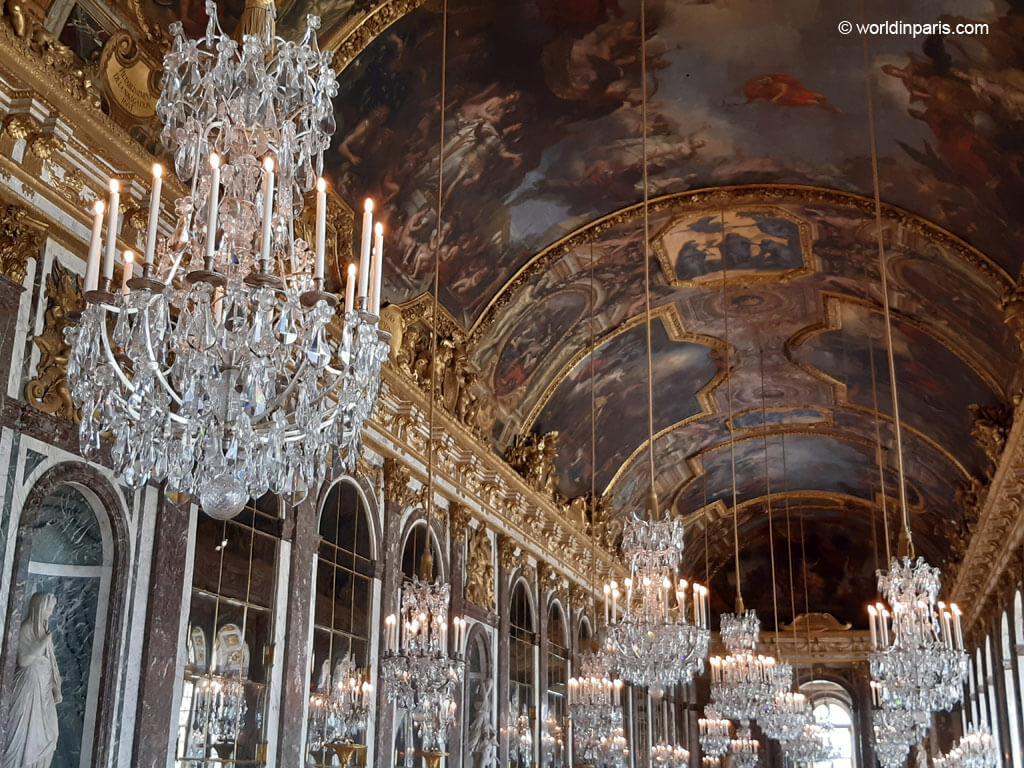
With the Versailles’ reopening after the first lockdown, the Hall of Mirrors could be seen only from the sides. This had the advantage of beautiful pictures with 0 crowds, and we really liked the idea!
GOOD TO KNOW: We have heard that some travelers book their Palace of Versailles skip-the-line tickets for the first time slot of the day, and once they enter the Palace, they go straight to the Hall of Mirrors to have pictures without crowds, and they visit the rest of the Palace later. After the first lockdown, the Palace proposes only a one-way itinerary, so if you go straight to the Hall of Mirrors, you won’t be allowed to go back to visit the first rooms later.
6. The Bull’s Eye Room
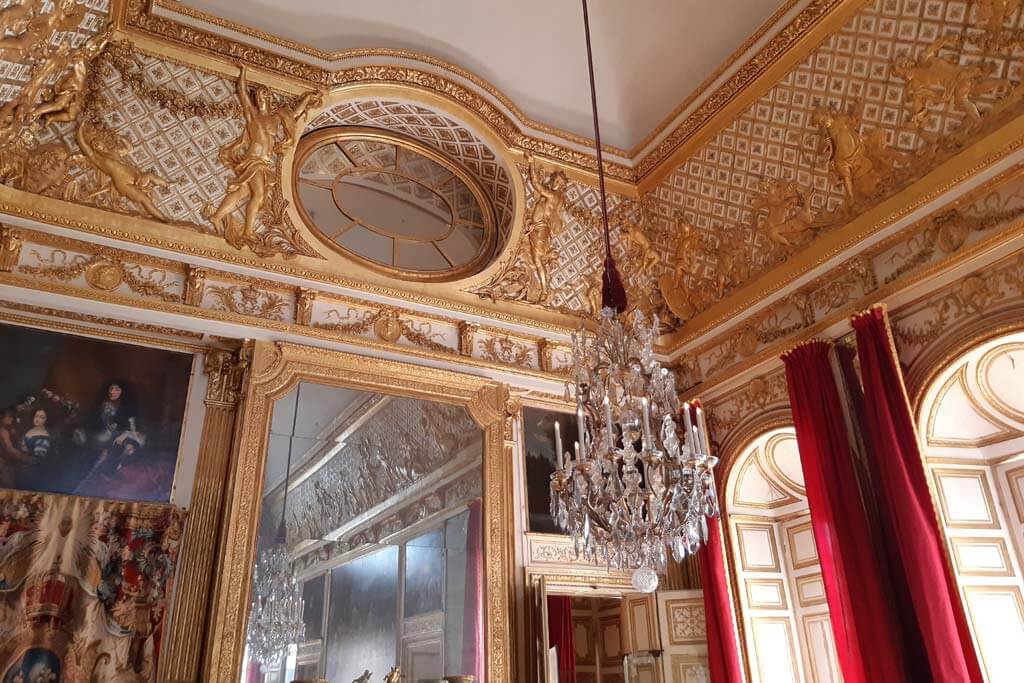
This small anti-chamber takes its name from the bull’s eye windows that you can see integrated into the ceiling frieze.
The Bull’s Eye Room is far from being the most impressive room inside the Palace of Versailles. Still, Americans visiting Paris will be interested to know that this is the room where Benjamin Franklin was waiting to be received by King Louis XVI in 1778 to get the military support of France in the War of Independence. That support later led to the signing of the American Declaration of Independence in Versailles in 1783.
7. The Queen’s Chamber
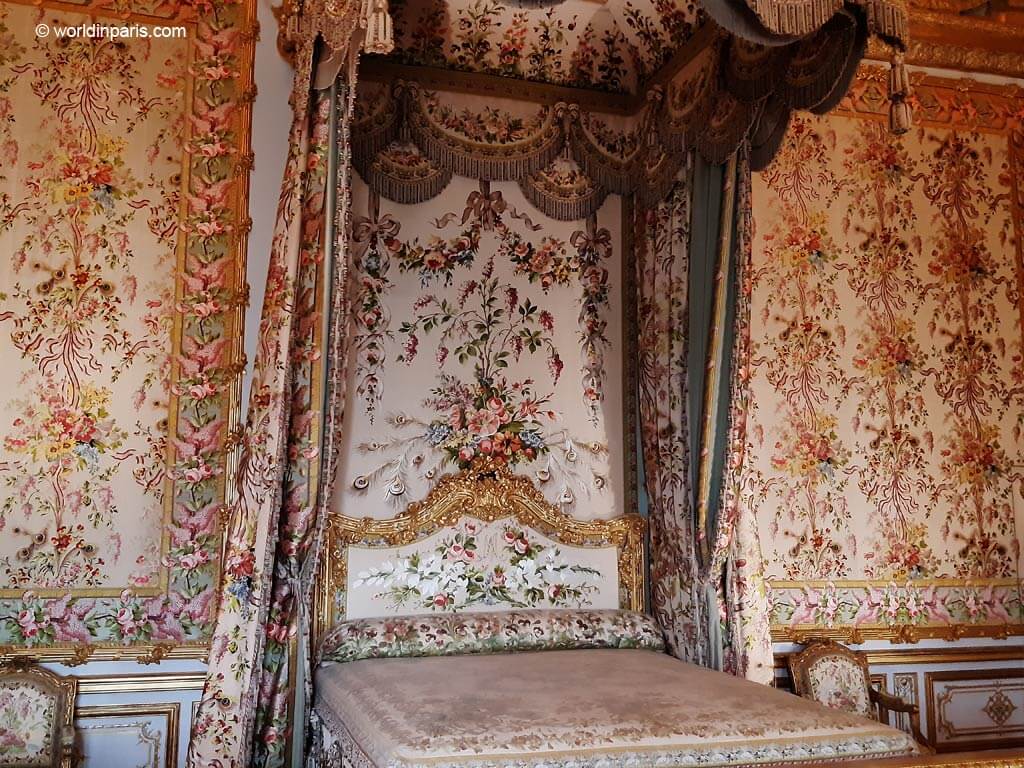
This is the main room of the Queen’s Apartments and also the most beautifully decorated. The Queen slept here, and she also held private audiences in this room.
The first two Queens in Versailles died in this room. Currently, this room displays a bust of Queen Marie-Antoinette, who also slept here. On your left, you can see the secret door that Queen Marie-Antoinette used to escape her apartments when the people assaulted Versailles.
READ MORE: Learn the story behind ‘Let Them Eat Cake’ Marie-Antoinette’s most famous quote.
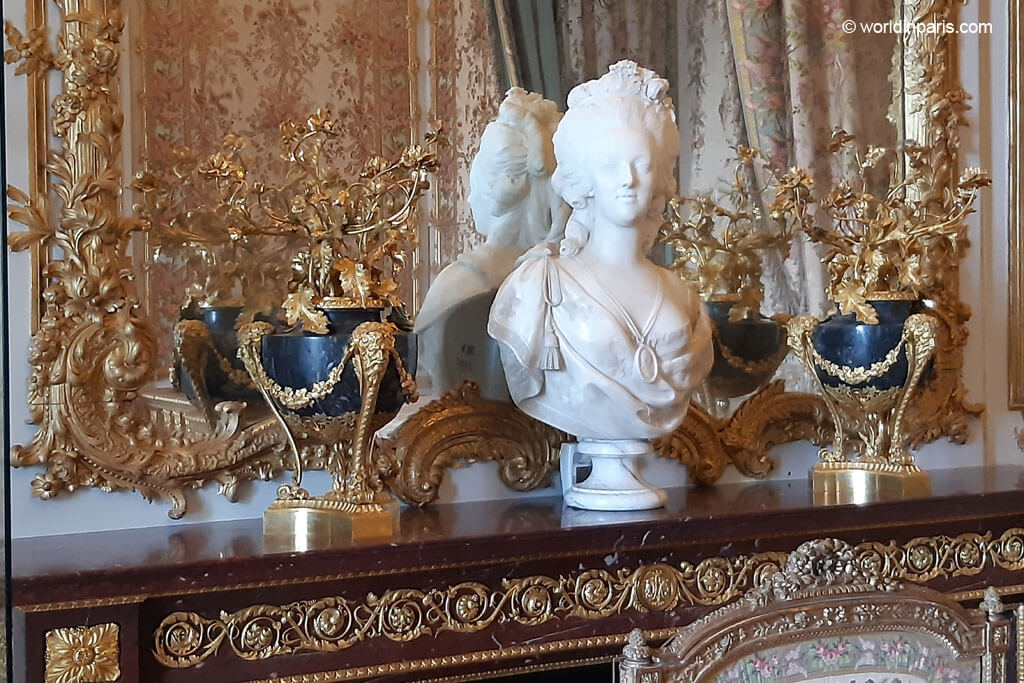
8. The Gallery of Great Battles
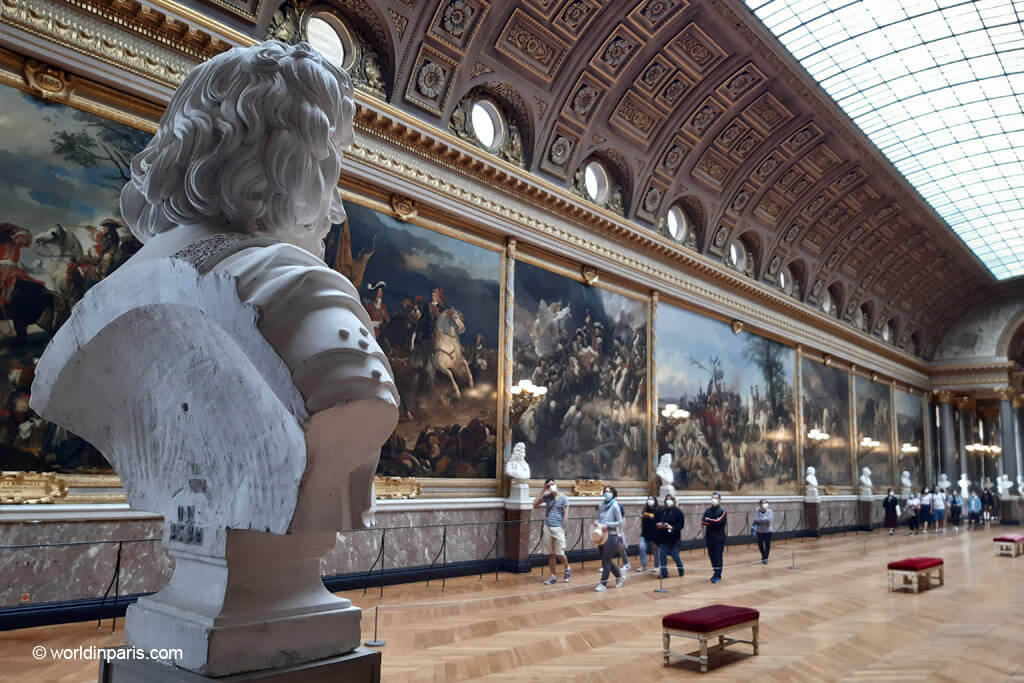
The visit to Versailles’ interior ends with the Gallery of Great Battles. This huge gallery is like an open book of French history. It was created much later by King Louis Philippe, who decided to make the Palace a French history museum.
The Gallery of Great Battles is decorated with 33 huge paintings celebrating French victories from 496 to 1809. If you want to learn more about French history, stop at the paintings that impress you most and read the short description of the battle.
The busts that decorate the gallery belong to princes, nobles, and important warmen who lost their lives in a battle. Do you recognize any of them?
Click here for more Versailles posts


